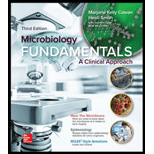
Microbiology Fundamentals: A Clinical Approach
3rd Edition
ISBN: 9781259709227
Author: Marjorie Kelly Cowan Professor, Heidi Smith
Publisher: McGraw-Hill Education
expand_more
expand_more
format_list_bulleted
Question
Chapter 7, Problem 20Q
Summary Introduction
To determine:
Three capabilities of enzymes that are used to identify microbial species in a clinical lab.
Concept introduction:
Each microbial species is different from other species. The microbes are identified and classified on the basis of these features. Several biochemical and physical tests are performed to distinguish the species.
Expert Solution & Answer
Want to see the full answer?
Check out a sample textbook solution
Students have asked these similar questions
Give only the mode of inheritance consistent with all three pedigrees and only two reasons that support this, nothing more, (it shouldn't take too long)
O
Describe the principle of homeostasis.
Chapter 7 Solutions
Microbiology Fundamentals: A Clinical Approach
Ch. 7.1 - Describe the relationship among metabolism,...Ch. 7.1 - Fully describe the structure and function of...Ch. 7.1 - Differentiate between constitutive and regulated...Ch. 7.1 - Diagram four major patterns of metabolic pathways.Ch. 7.1 - Describe how enzymes are controlled.Ch. 7.1 - NCLEX PREP 2. An enzyme that catalyzes starch is...Ch. 7.2 - Name the chemical in which energy is stored in...Ch. 7.2 - Create a general diagram of a redox reaction.Ch. 7.2 - Identify electron carriers used by cells.Ch. 7.2 - Prob. 3NP
Ch. 7.3 - Name the three main catabolic pathways and the...Ch. 7.3 - Construct a paragraph summarizing glycolysis.Ch. 7.3 - Describe the Krebs cycle, with emphasis on what...Ch. 7.3 - Discuss the significance of the electron transport...Ch. 7.3 - State two ways in which anaerobic respiration...Ch. 7.3 - Summarize the steps of microbial fermentation, and...Ch. 7.3 - Describe how noncarbohydrate compounds are...Ch. 7.3 - Q. From this information, can you identify another...Ch. 7.4 - Prob. 16AYPCh. 7.4 - Define amphibolism.Ch. 7.4 - Prob. 2MMCh. 7 - NCLEX PREP 1. Which of the following is/are...Ch. 7 - Prob. 1QCh. 7 - Prob. 2QCh. 7 - Prob. 3QCh. 7 - Prob. 4QCh. 7 - Prob. 5QCh. 7 - Prob. 6QCh. 7 - Prob. 7QCh. 7 - Prob. 8QCh. 7 - Prob. 9QCh. 7 - Prob. 10QCh. 7 - Prob. 11QCh. 7 - Prob. 12QCh. 7 - Prob. 13QCh. 7 - Prob. 14QCh. 7 - Prob. 15QCh. 7 - Prob. 16QCh. 7 - Defend this statement: Microbes (and their...Ch. 7 - Prob. 18QCh. 7 - Prob. 19QCh. 7 - Prob. 20QCh. 7 - Polymerase chain reaction (PCR) is a lab...Ch. 7 - From chapter 3, figure 3.15. On these depictions...
Knowledge Booster
Learn more about
Need a deep-dive on the concept behind this application? Look no further. Learn more about this topic, biology and related others by exploring similar questions and additional content below.Similar questions
- Explain how the hormones of the glands listed below travel around the body to target organs and tissues : Pituitary gland Hypothalamus Thyroid Parathyroid Adrenal Pineal Pancreas(islets of langerhans) Gonads (testes and ovaries) Placentaarrow_forwardWhat are the functions of the hormones produced in the glands listed below: Pituitary gland Hypothalamus Thyroid Parathyroid Adrenal Pineal Pancreas(islets of langerhans) Gonads (testes and ovaries) Placentaarrow_forwardDescribe the hormones produced in the glands listed below: Pituitary gland Hypothalamus Thyroid Parathyroid Adrenal Pineal Pancreas(islets of langerhans) Gonads (testes and ovaries) Placentaarrow_forward
- Please help me calculate drug dosage from the following information: Patient weight: 35 pounds, so 15.9 kilograms (got this by dividing 35 pounds by 2.2 kilograms) Drug dose: 0.05mg/kg Drug concentration: 2mg/mLarrow_forwardA 25-year-old woman presents to the emergency department with a 2-day history of fever, chills, severe headache, and confusion. She recently returned from a trip to sub-Saharan Africa, where she did not take malaria prophylaxis. On examination, she is febrile (39.8°C/103.6°F) and hypotensive. Laboratory studies reveal hemoglobin of 8.0 g/dL, platelet count of 50,000/μL, and evidence of hemoglobinuria. A peripheral blood smear shows ring forms and banana-shaped gametocytes. Which of the following Plasmodium species is most likely responsible for her severe symptoms? A. Plasmodium vivax B. Plasmodium ovale C. Plasmodium malariae D. Plasmodium falciparumarrow_forwardStandard Concentration (caffeine) mg/L Absorbance Reading 10 0.322 20 0.697 40 1.535 60 2.520 80 3.100arrow_forward
- please draw in the answers, thank youarrow_forwarda. On this first grid, assume that the DNA and RNA templates are read left to right. DNA DNA mRNA codon tRNA anticodon polypeptide _strand strand C с A T G A U G C A TRP b. Now do this AGAIN assuming that the DNA and RNA templates are read right to left. DNA DNA strand strand C mRNA codon tRNA anticodon polypeptide 0 A T G A U G с A TRParrow_forwardplease answer all question below with the following answer choice, thank you!arrow_forward
arrow_back_ios
SEE MORE QUESTIONS
arrow_forward_ios
Recommended textbooks for you
- Surgical Tech For Surgical Tech Pos CareHealth & NutritionISBN:9781337648868Author:AssociationPublisher:Cengage
- Essentials of Pharmacology for Health ProfessionsNursingISBN:9781305441620Author:WOODROWPublisher:Cengage
 Principles Of Radiographic Imaging: An Art And A ...Health & NutritionISBN:9781337711067Author:Richard R. Carlton, Arlene M. Adler, Vesna BalacPublisher:Cengage Learning
Principles Of Radiographic Imaging: An Art And A ...Health & NutritionISBN:9781337711067Author:Richard R. Carlton, Arlene M. Adler, Vesna BalacPublisher:Cengage Learning


Surgical Tech For Surgical Tech Pos Care
Health & Nutrition
ISBN:9781337648868
Author:Association
Publisher:Cengage


Essentials of Pharmacology for Health Professions
Nursing
ISBN:9781305441620
Author:WOODROW
Publisher:Cengage

Principles Of Radiographic Imaging: An Art And A ...
Health & Nutrition
ISBN:9781337711067
Author:Richard R. Carlton, Arlene M. Adler, Vesna Balac
Publisher:Cengage Learning

Biochemical Tests-Part 1; Author: Southern Stacker;https://www.youtube.com/watch?v=a-i9vANfQWQ;License: Standard Youtube License